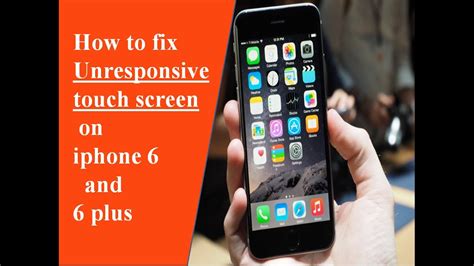Why is my iPhone screen unresponsive?
Are you frustrated with your iPhone screen being unresponsive? Don’t worry, you’re not alone. Many iPhone users have experienced this issue at some point. It can be incredibly frustrating when you’re unable to navigate your device or use any of its features. In this blog post, we will explore the possible reasons why your iPhone screen may be unresponsive and discuss some solutions to fix this problem.
One possible reason for an unresponsive iPhone screen is software-related issues. If your device’s software is outdated or if it has encountered a glitch, it can lead to unresponsiveness. To address this, checking for software updates is crucial. Apple regularly releases software updates to fix bugs and improve the performance of their devices. By keeping your iPhone’s software up to date, you can ensure that any known issues are resolved, and your device functions optimally.
Another common solution to fix an unresponsive iPhone screen is to restart your device. This simple action can often resolve minor software glitches and refresh your device. To restart an iPhone, you can press and hold the power button until the “Slide to power off” option appears. Once it appears, slide the button to turn off your device. After a few seconds, press and hold the power button again until the Apple logo appears, indicating that your device is restarting.
In some cases, if the unresponsiveness persists, you may need to resort to force restarting your iPhone. This method is useful when your device is completely frozen and unresponsive to any touch inputs. The process of force restarting varies depending on the iPhone model you have. You can find the specific steps on Apple’s official website or by performing a quick search.
In conclusion, an unresponsive iPhone screen can be a frustrating experience. However, by checking for software updates, restarting your device, and, if necessary, force restarting it, you can often resolve this issue. Remember to always keep your iPhone’s software up to date and consider seeking professional assistance if the problem persists. With these steps, you can hopefully regain the functionality of your iPhone screen and continue using your device seamlessly.
Restarting your iPhone to fix unresponsiveness
The iPhone has become an essential part of our daily lives, helping us stay connected, navigate, entertain ourselves, and much more. However, it can be incredibly frustrating when your iPhone screen becomes unresponsive. This issue can be caused by various factors, such as software glitches, hardware problems, or even a simple software update that may have gone wrong. But before you rush to seek professional assistance or dive into complex troubleshooting methods, one of the simplest and most effective solutions is to restart your iPhone.
When your iPhone screen becomes unresponsive, a quick restart can often resolve the issue. Restarting your iPhone is similar to restarting a computer. It helps in clearing temporary files, refreshing system processes, and can potentially fix any software-related problems that could be causing the unresponsiveness. To restart your iPhone, follow these simple steps:
- Press and hold the power button (located on the side or top of your iPhone) until the “slide to power off” option appears on the screen.
- Swipe the power off slider from left to right to turn off your iPhone.
- After your iPhone is completely turned off, press and hold the power button again until the Apple logo appears on the screen.
- Your iPhone will now start up, and hopefully, the unresponsiveness issues will be resolved.
Restarting your iPhone not only helps in fixing unresponsiveness but can also improve overall performance and eliminate any temporary glitches or bugs. It is a simple yet powerful troubleshooting method that should be your first step whenever your iPhone screen becomes unresponsive.
Checking for software updates
Regularly checking for software updates is an essential task for every iPhone owner. These updates not only bring new features and improvements but also fix any bugs or security vulnerabilities that may exist in your device’s operating system. By keeping your iPhone up to date, you ensure that it runs smoothly and efficiently, providing you with the best user experience possible.
There are several ways to check for software updates on your iPhone. One way is to go to the “Settings” app and navigate to “General” settings. Scroll down and tap on “Software Update.” Your iPhone will then check for any available updates. If there is an update available, you can tap on “Download and Install” to begin the update process. Make sure that your iPhone is connected to a stable Wi-Fi network and has sufficient battery power before initiating the update.
Another way to check for software updates is through iTunes on your computer. Connect your iPhone to your computer using a Lightning cable and open iTunes. Select your iPhone from the device menu, and in the summary tab, click on “Check for Update.” iTunes will then check for any available updates and prompt you to download and install them.
Updating your iPhone’s software is crucial for a variety of reasons. Firstly, software updates often include new features and enhancements that can enhance the functionality of your device. These updates may introduce improvements to existing apps, add new capabilities, and improve overall performance.
Moreover, software updates address any known bugs or issues in the previous versions of the operating system. These bugs can cause various problems, such as app crashing, system instability, or connectivity issues. By installing the latest updates, you can fix these problems and ensure that your iPhone operates smoothly.
Most importantly, software updates frequently include security patches and fixes. As technology advances, so do the methods used by hackers and malicious actors. Software updates help protect your iPhone by patching any security vulnerabilities that may exist. By keeping your device up to date, you reduce the risk of falling victim to malware, data breaches, or other security threats.
In conclusion, checking for software updates on your iPhone is vital to ensure that your device runs optimally and remains secure. Regularly installing these updates not only adds new features and enhances performance but also addresses any bugs or security vulnerabilities. By following the simple steps mentioned above, you can effortlessly keep your iPhone up to date and enjoy the latest features and utmost security.
Force restarting your iPhone
Force restarting your iPhone can be a useful solution when your device becomes unresponsive or frozen. This action, also known as a hard reset, can help resolve minor software glitches or temporary issues. Unlike a regular restart, a force restart involves a more abrupt shutdown and power-up sequence that can refresh the system and potentially fix the problem. In this blog post, we will guide you on how to force restart different iPhone models.
Before we proceed with the instructions, it’s important to note that force restarting your iPhone will not erase any of your data or settings. However, it is always recommended to regularly back up your device to iCloud or iTunes, just in case.
To force restart an iPhone, you need to follow different steps depending on the model you own:
Force Restarting an iPhone 6s or older
1. Begin by pressing and holding the Home button located below the screen.
2. While still holding the Home button, simultaneously press and hold the Power button (located on the top or side of the device).
3. Continue holding both buttons for about 10 seconds until the Apple logo appears on the screen.
Force Restarting an iPhone 7 or 7 Plus
1. Start by pressing and holding the Volume Down button (located on the left side of the device).
2. While still holding the Volume Down button, simultaneously press and hold the Power button (located on the right side of the device).
3. Keep holding both buttons for around 10 seconds until the Apple logo appears on the screen.
Force Restarting an iPhone 8, 8 Plus, X, XS, XS Max, XR, 11, 11 Pro, or 11 Pro Max
1. Begin by quickly pressing and releasing the Volume Up button.
2. Next, quickly press and release the Volume Down button.
3. Finally, press and hold the Side or Power button (located on the right side of the device) until you see the Apple logo on the screen.
By performing a force restart on your iPhone, you are essentially giving it a fresh start and allowing the software to reboot. This method can help in resolving unresponsiveness, freezing, or random glitches you may encounter. However, if the issue persists even after force restarting, you may need to explore other troubleshooting options or seek professional assistance.
Remember to try force restarting your iPhone only when necessary, as it should not be a regular routine. It’s important to diagnose the underlying cause of the problem before applying any potential fixes. If unsure, don’t hesitate to reach out to Apple support or visit an authorized service center for further guidance.
Calibrating the touch screen sensitivity
Are you experiencing issues with your iPhone’s touch screen? Is it not responding properly to your touch or registering inaccurate inputs? If so, you might need to calibrate the touch screen sensitivity. It is a simple process that can help improve the overall performance of your device’s touch screen.
Firstly, let’s understand what touch screen calibration means. Essentially, it is the process of optimizing the responsiveness and accuracy of your iPhone’s touch screen by making adjustments to the way it registers your touch. Calibration ensures that your touch inputs are accurately recognized, resulting in a smoother and more efficient user experience.
To calibrate the touch screen sensitivity on your iPhone, follow these easy steps:
- Start by navigating to the “Settings” app on your device.
- Scroll down and tap on “General.”
- Next, look for the “Accessibility” option and tap on it.
- In the Accessibility menu, select “Touch.”
- Inside the Touch menu, you will find various options related to touch sensitivity. Adjust them according to your preference and needs. For example, if you want a more sensitive touch screen, move the slider towards the right. Conversely, if you want a less sensitive touch screen, move the slider towards the left.
- After making the desired adjustments, test the touch screen sensitivity by tapping and swiping on different areas of the screen.
- If you are still facing issues with touch screen responsiveness, you can repeat the process and fine-tune the sensitivity settings until you achieve the desired results.
Calibrating the touch screen sensitivity can often resolve common issues like unresponsive touch or inaccurate touch inputs. It is a quick and easy solution to try before seeking further assistance.
Remember, touch screen sensitivity preferences can vary from person to person, so feel free to experiment and adjust the settings until you find the perfect balance that suits your needs. Keep in mind that calibrating the touch screen sensitivity does not require any professional expertise, making it an accessible solution for most iPhone users.
In conclusion, if you are experiencing touch screen issues on your iPhone, such as unresponsiveness or inaccurate touch inputs, calibrating the touch screen sensitivity can be a useful troubleshooting step. Follow the simple steps outlined above to adjust the touch sensitivity settings and improve your overall user experience. However, if the problem persists even after calibration, it may be necessary to seek professional assistance to diagnose and resolve any underlying hardware issues.
Clearing temporary files and app caches
One common issue that many iPhone users encounter is a slow or unresponsive device. Often, this can be due to a buildup of temporary files and app caches that have accumulated over time. These files take up valuable storage space and can cause your iPhone to lag or freeze. To optimize the performance of your device, it is recommended to regularly clear out these temporary files and app caches.
Firstly, let’s understand what temporary files and app caches are. Temporary files are files that are created and stored by apps for various purposes, such as saving preferences or storing data temporarily. App caches, on the other hand, are files stored by apps to help them load faster and provide a smoother user experience. While these files can be useful at times, an excess of them can result in decreased performance of your iPhone.
So, how can you clear these temporary files and app caches? Fortunately, Apple has provided a simple and straightforward way to do so. Follow these steps to clean up your iPhone:
- Open the “Settings” app on your iPhone.
- Scroll down and tap on “General”.
- Tap on “iPhone Storage” (or “iPad Storage” if you have an iPad).
- Wait for a few moments as your device calculates the storage usage.
- Under the “Recommendations” section, you will find options to “Offload Unused Apps” and “Review Large Attachments”. You can utilize these options to free up storage space but they do not directly clear temporary files and app caches.
- Keep scrolling down until you reach the list of installed apps. Tap on any app that you want to clear the cache for.
- In the app settings, you will find the amount of storage the app is using. Tap on “Offload App” to free up storage space, or tap on “Delete App” to remove the app and all of its data, including temporary files and app caches.
- Repeat these steps for other apps that you want to clean up.
It is important to note that clearing temporary files and app caches may result in the loss of some temporary data. However, this is typically insignificant and won’t affect the overall performance of your apps. If you encounter any issues after clearing these files, you can simply relaunch the app, and it will recreate the necessary cache files as required.
In conclusion, clearing temporary files and app caches is a vital step in maintaining the optimal performance of your iPhone. By regularly cleaning up these files, you can enjoy a faster and more responsive device. Remember to repeat this process periodically to keep your iPhone running smoothly.
Resetting all settings as a last resort
When it comes to troubleshooting an unresponsive iPhone screen, there are several steps you can take. One of the last options you may consider is resetting all settings on your device. While this can be a drastic measure, it can sometimes resolve persistent issues that other troubleshooting steps have failed to fix. In this blog post, we will explore the process of resetting all settings on your iPhone as a last resort.
Before proceeding with a reset, it’s important to understand that this action will erase all personalized settings on your device. This includes Wi-Fi passwords, display settings, privacy preferences, and more. However, your data, apps, and media will remain intact. To reset all settings on your iPhone, follow these steps:
- Open the “Settings” app on your iPhone.
- Scroll down and tap on “General”.
- Scroll to the bottom and select “Reset”.
- Choose “Reset All Settings”.
- Enter your passcode if prompted.
- Confirm the reset by tapping “Reset All Settings” again.
Once the reset process is complete, your iPhone will restart and all settings will be restored to their default values. You will need to reconfigure any personalized settings, such as wallpaper, notifications, and accessibility options. It’s important to note that resetting all settings will not erase your data, but it’s always a good idea to create a backup of your device before attempting any major changes.
Resetting all settings can be a helpful troubleshooting step when other solutions have failed to rectify an unresponsive iPhone screen. However, it should be considered as a last resort due to the inconvenience of reconfiguring your device settings. If the issue persists even after a complete settings reset, it may be necessary to seek professional assistance or contact Apple Support for further guidance.
Seeking professional assistance for hardware issues
When it comes to hardware issues with your iPhone, seeking professional assistance is often the best course of action. While there are some troubleshooting steps you can take on your own, certain problems may require the expertise of a trained technician. Here are a few reasons why seeking professional assistance for hardware issues is important:
1. Specialized Knowledge: Apple certified technicians have undergone rigorous training and have in-depth knowledge of iPhone hardware components. They are equipped with the necessary skills and expertise to diagnose and fix complex hardware problems.
2. Genuine Parts: Authorized service providers have access to genuine Apple parts that are specifically designed for your iPhone model. By taking your device to a professional, you ensure that any replacement parts used are of high quality and compatible with your device, which helps to maintain its performance and longevity.
3. Warranty Coverage: If your iPhone is still under warranty, seeking professional assistance is essential. Attempting to repair the device yourself or going to an unauthorized repair shop can void your warranty. By choosing an authorized service provider, you can ensure that any repairs or replacements are covered under your warranty.
While some minor software issues can be resolved by following online tutorials, it is important to recognize when a hardware problem requires professional intervention. By seeking assistance from authorized technicians, you can ensure that your iPhone is in capable hands and receive the best possible solution for any hardware issues you may encounter.
Frequently Asked Questions
Why is my iPhone screen unresponsive?
There can be several reasons for an unresponsive iPhone screen. It could be due to a software glitch, outdated software, hardware issues, or even a calibration problem.
How can I fix an unresponsive iPhone screen?
There are several troubleshooting steps you can try to fix an unresponsive iPhone screen. Start by restarting your iPhone, checking for software updates, or force restarting your device. If the issue persists, you can try calibrating the touch screen sensitivity, clearing temporary files and app caches, or resetting all settings as a last resort.
Why should I restart my iPhone to fix unresponsiveness?
Restarting your iPhone is a simple and effective way to resolve temporary software glitches. It can help refresh the system and clear any minor issues that might be causing the screen to become unresponsive.
How do I check for software updates on my iPhone?
To check for software updates on your iPhone, go to the “Settings” app, select “General,” and then tap on “Software Update.” If a new update is available, follow the on-screen instructions to download and install it. Software updates often include bug fixes and improvements that can fix unresponsiveness issues.
How do I force restart my iPhone?
Force restarting your iPhone can help resolve more stubborn issues. The steps to force restart may vary depending on the iPhone model. For most iPhone models, you can press and hold the power button and volume down button simultaneously until the Apple logo appears. Consult the Apple support website or user manual for specific instructions for your iPhone model.
Why should I calibrate the touch screen sensitivity on my iPhone?
Calibrating the touch screen sensitivity can help improve its accuracy and responsiveness. If you notice that certain areas of the screen are less responsive to touch, calibrating it can help realign the touch input and make it more accurate.
When should I consider seeking professional assistance for my iPhone’s unresponsive screen?
If you have tried all the troubleshooting steps mentioned above and your iPhone screen is still unresponsive, it’s advisable to seek professional assistance. A certified technician can diagnose any hardware issues that may be causing the problem and provide a proper solution.





